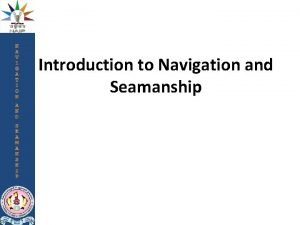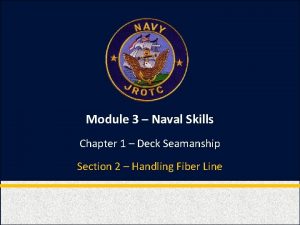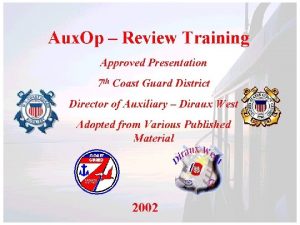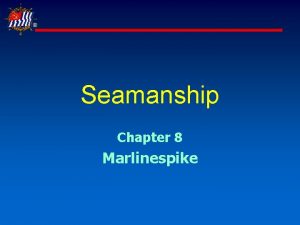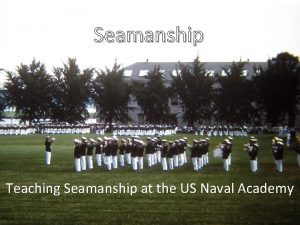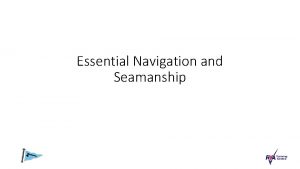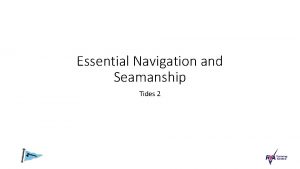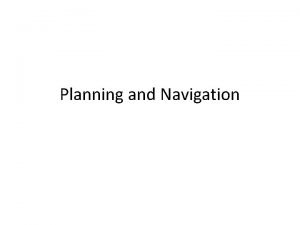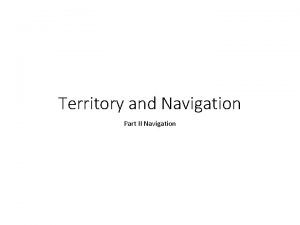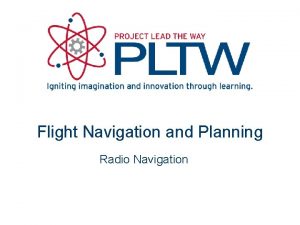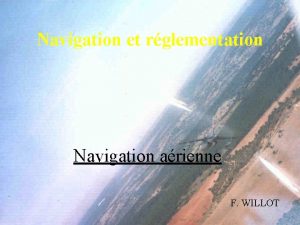Introduction to Navigation and Seamanship Navigation is the














- Slides: 14

Introduction to Navigation and Seamanship

• Navigation is the process of directing or conducting the movement of a vehicle/vessel from one place to another, safely. • The word navigation derived from two Latin words “navis” means a ship, “agere” means to direct. • Navigation is a mixture of an art and a science. It is considered as science because involves the development and use of instruments, methods, almanacs and tables.

History of Navigation • • • earliest form of navigation - piloting; the determination of position relative to land marks, natural or manmade. When man became brave enough to venture out of sight of objects, a new form of navigation was born dead reckoning. earliest compass- wind, waves, sun, celestial body and flight of birds. magnetic compass -earliest instruments provided to the navigator. in 1519, the quadrant (fore runner of the sextant), globes of the world, magnetic compass were in use. chronometer was invented in the 18 th century and the correct time was known aboard ship that longitude could be determined.

• • • In 1960’s first navigation satellites were put into orbit- which broadcast radio signals by which ship could navigate. Electronic navigation includes all forms of navigation by an electromagnetic wave (radio wave). The term electric navigation has been applied to all navigation system involving use of electronic components, including radio navigation system, sonar, satellite navigation systems. Navigation methods and techniques vary with the type of vessel, the conditions, and the navigator’s experience. The science of navigation can be taught, but the art of navigation must be developed from experience.

Types of Navigaiton

Piloting (Coastal Navigation) • Piloting involves frequent determination of position relative to geographic and hydrographic features. • Piloting-determination of the position and the direction of the movements of a vessel involving frequent or continuous reference to landmarks, aids to navigation and depth soundings. • Land marks -natural land features, structures and other objects ashore which although not constructed for that purpose, can guide the mariner. • Piloting is done only in coastal water where we have a sight on land. • Piloting normally provides a vessel’s position with precision and accuracy. • The term aids to navigation mean any object or device, external to a vessel, that is used to assist a navigator in fixing his position or determining a safe course. • Lighthouses, light buoys, beacons, towers, churches, mountains are examples for aids to navigation.

Dead Reckoning (DR) • As man become bolder, he travelled beyond the range of visual reference to natural or manmade land marks. • The term is derived from “deduced reckoning” of sailing ships which is renamed as “dead reckoning”. • Dead Reckoning (DR) is the fixing of a present position or anticipated (expected) future position, from a previous position using known directions and distances. • DR positions can be done -which automatically analyses directions and distances and plot a continuous track. • The DR position is only an approximation, because the wind, current, waves and steering errors are not taken to account.

Celestial Navigation • Celestial navigation - determination of position by observing the celestial bodies such as the Sun, Moon, planets and stars, by drawing lines of position using tables, spherical trigonometry, and almanacs. • Though Electronic devices are widely used, the celestial navigation remains a basic and widely used procedure for determining positions at sea.

Radio Navigation • • • Radio navigation - determination of position and to lesser extent, course direction using information gained from radio waves received and processed on board a vessel or aircraft. It uses radio waves to determine position by either radio direction finding systems or hyperbolic systems. Radar navigation also uses radar to determine the distance from or bearing of objects whose position is known, in addition to the collision avoidance system. Radar is ‘electronic piloting’ and the use of satellites is a unique application of radio waves. Radio navigation system in general provides coverage of a few hundred to many thousands of miles with accuracies from + 5 miles.

Electronic Navigation • Electronic navigation-finding of position by using information gained from electronic equipments onboard a vessel. • The term “electronic navigation”, sometimes used more properly includes all electronic devices such as radar, radio beacon, Decca, Loran-c, Omega and satellites are employed in this navigation.

Satellite Navigation • Satellite navigation uses artificial earth satellites for determination of position. • The above methods are giving solutions to the following 3 basic problems of any navigator at sea, o o o • How to determine the position of a vessel? How to determine the direction of vessel’s movement? How to determine distance that covered by a vessel? Position: o The term position refers to any identifiable location on the earth or a point within a man-made system of artificial coordinates.

Direction: o Knowledge of the spatial relationship between two positions o Orientation of an imaginary line joining one point to another without regard to the distance between them o Measured in angular units, degree of arc from a reference using a polar coordinate system. The usual reference direction is True North or Geographic North. Distance: o Spatial separation between two points without regard to direction. o The “mile” commonly used by navigators is the International Nautical Mile, which is equal to 6076. § 1 Nautical Mile = 6076. 1 feet § (1 Statute Mile on land = 5280 feet) § 1 Nautical Mile = 1. 852 km =1852 m § [1 fathom = 1. 829 m=6 feet (1 foot – 0. 3048 m)]

• Speed is defined as the time rate of movement and in navigation is usually measured in Nautical Mile per Hour or “Knots”. (Note: “Knots per hour” is a wrong usage). • Time is written as four digits in a 24 hour system. The time 04: 32 A. M. would be written as 0432; and 8: 15 P. M would be written as 2015. Azimuth: The arc of the horizon between the meridian of a place and a vertical circle passing through any celestial body. Zenith: The point on the celestial sphere vertically above the observer’s head, one of the two poles of the horizon. Seamanship • Seamanship is an art of handling a ship under all condition of weather, tide or other influences affecting its movement or safety of a ship. • The variety of skills needed to enable the safe and efficient operation of any boat, even under stressful weather conditions are called seamanship. • Seamanship skills include safety at sea, maintenance, knot typing, hitching, splicing, ropes and wires, mending of nets, cargo handling. operation of deck equipment, anchors and cables; rope work and line handling; communications; sailing; engines; towing; dealing with emergencies; survival at sea and search and rescue; fire fighting.

• Ship-handling: o A fundamental skill of professional seamanship is being able to manoeuvre a vessel with accuracy and precision. o Seamanship is the name for excellence in boat handling, and its scope is so wide that even the most experienced sailor cannot hope to learn everything about it in one lifetime.
 Navigation and seamanship
Navigation and seamanship Seamanship knots and hitches
Seamanship knots and hitches Marlinspike seamanship
Marlinspike seamanship Hát kết hợp bộ gõ cơ thể
Hát kết hợp bộ gõ cơ thể Lp html
Lp html Bổ thể
Bổ thể Tỉ lệ cơ thể trẻ em
Tỉ lệ cơ thể trẻ em Chó sói
Chó sói Chụp phim tư thế worms-breton
Chụp phim tư thế worms-breton Bài hát chúa yêu trần thế alleluia
Bài hát chúa yêu trần thế alleluia Các môn thể thao bắt đầu bằng tiếng nhảy
Các môn thể thao bắt đầu bằng tiếng nhảy Thế nào là hệ số cao nhất
Thế nào là hệ số cao nhất Các châu lục và đại dương trên thế giới
Các châu lục và đại dương trên thế giới Công thức tính thế năng
Công thức tính thế năng Trời xanh đây là của chúng ta thể thơ
Trời xanh đây là của chúng ta thể thơ
